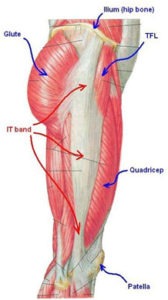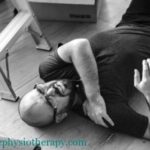Iliotibial Band Friction Syndrome
It is one of the common causes of “Runner’s Knee“. This is again a type of overuse injuries in runners. Being an overuse injury, it is caused by repeated trauma rather than a specific incident.
The ITB attaches to a bony prominence on the lateral femoral condyle on the outside of the knee. The IT band slides forwards and backward across this bony prominence with movement. This repetitive sliding can create excess friction, especially when the knee is bent at 30 degrees, which commonly happens just as the foot strikes the ground in running. At this region of 30 degrees of knee flexion, the structures on the lateral aspect pinch or irritates, thereby producing IT Band Friction Syndrome
Iliotibial Band
The ITB, or Iliotibial band, is a long, thin band of fascia that runs down the outside of the thigh. Superiorly it is attached to Tensor Fascia Lata (TFL) muscle and Gluteus Maximus, and, at the bottom, it attaches to the tibia and femoral condyle. It also sends few fibers to the patellar retinaculum.

Causes of IT Band Friction Syndrome
Essentially it is caused by altered running biomechanics due to underlying muscular imbalances. The biomechanics can alter because of muscle imbalance (weakness or tightness), fatigue, and ground impact issues.
The most common causes include,
- Poor biomechanics (running technique); particularly inwards rolling knees and hips
- Weak hip / gluteal muscles
- Weak hip rotators
- Weak inner quadriceps
- Weak core muscles
- Poor foot arch control
- A sudden increase in training intensity
- Excessive downhill training in runners
- Endurance running (training for half and full marathons, ultra-marathons)
Symptoms of IT Band Friction Syndrome
The symptoms of IT Band Friction Syndrome vary in severity. The most common symptoms include:
- Sharp or burning pain on the lateral aspect (outer part) of the knee.
- Pain that worsens with continuous running or other repetitive knee bending and straightening activities
- Swelling over the outside of the knee.
- Pain during early knee bending
- Gradual onset of symptoms which if persists for more than 4 weeks can cause severe sport or activity interference.
Diagnosis
A thorough evaluation by a Physiotherapist can easily diagnose IT Band Friction Syndrome. The most important part is discovering the contributing factors to the problem. If this isn’t determined IT Band friction syndrome will reoccur after sometime. Normally any further investigations, such as scans are not required.
Treatment of IT Band Friction Syndrome
- Physiotherapy
Aims of Physiotherapy treatment:
- Reduce pain and inflammation.
- Splinting to unload IT band.
- Modifying training regime to reduce pain and prevent a recurrence.
- Normalize joint range of motion of hip, knee, and ankle.
- Strengthen knee, hip, and leg muscles
- Normalize lower limb muscle lengths.
- Improve proprioception, agility, and balance.
- Correct running and landing techniques.
- ITB Surgery
In severe cases, a Z-lengthening procedure is undertaken to surgically lengthen the IT band. During the process debridement of irritating structure that overlies the femoral condyle is done. This is the last resort as most cases respond well to conservative treatment or physiotherapy.
As in all orthopedic cases of surgery, post-operative rehabilitation is the most important part and should not be neglected. The most successful and quickest outcomes result from the guidance and supervision of an experienced Physiotherapist.
For more appropriate advice, consult a Physiotherapist for IT Band Friction Syndrome in Dwarka, Delhi.





